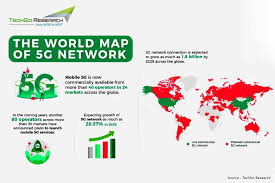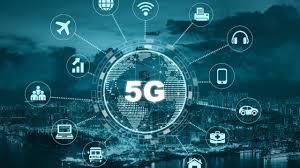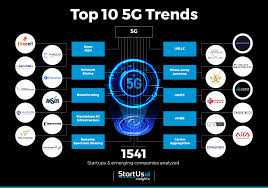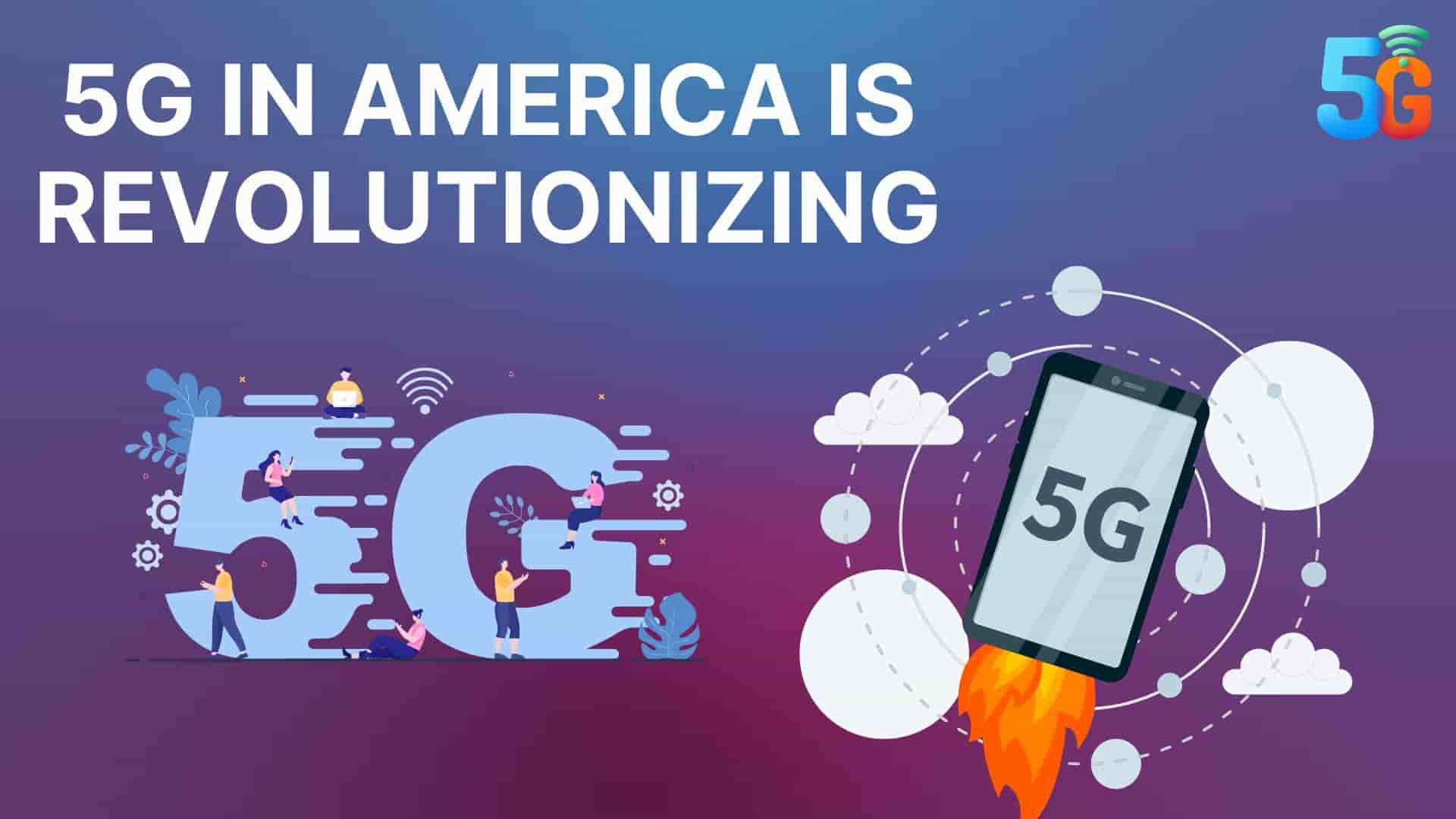Introduction: Is 5G Your New Superpower?
Imagine this: you’re binge-watching a 4K series on your phone, downloading a massive video game in seconds, and your smart fridge is quietly ordering your weekly groceries—all without a hint of lag. Sounds like something out of a sci-fi flick, doesn’t it? Well, welcome to 2025, where 5G in America is making this high-tech dream a reality for millions.
According to Qualcomm, over 60% of Americans now have access to 5G networks, delivering speeds up to 100 times faster than 4G. From teenagers glued to TikTok to grandparents mastering Zoom calls, 5G in America is transforming how we live, work, and play. This 2025 guide dives deep into how 5G is reshaping everyday life for all ages, with a sprinkle of humor and a lot of insight. Ready to explore the high-speed future? Buckle up!
Read more: AI and Technology in America- Best Insights 2025
What is 5G in America?
Breaking Down 5G Technology
Let’s get the basics out of the way: what exactly is 5G? Short for fifth-generation wireless, 5G is the latest leap in mobile network technology, and it’s a big deal. Unlike 4G, which could feel like a snail on a bad day, 5G in America offers blazing-fast speeds, ultra-low latency, and the ability to connect millions of devices at once.
Major carriers like Verizon, AT&T, and T-Mobile have been rolling out 5G networks across the country, from bustling cities to rural towns. According to Qualcomm, 5G delivers download speeds up to 1 Gbps—imagine downloading an entire HD movie in under 10 seconds! Plus, its latency (the time it takes for data to travel) is as low as 1 millisecond, compared to 4G’s 20–30 milliseconds. That’s like the difference between a cheetah and a tortoise.
5G achieves this magic through advanced radio frequencies, including high-band millimeter waves and mid-band spectrum, paired with small-cell technology. These small cells are like mini towers dotted around cities, ensuring stronger signals and less congestion. For the tech-curious, 5G also uses beamforming to direct signals precisely to your device, making connections more reliable. Whether you’re streaming, gaming, or running a smart home, 5G in America is designed to handle it all without breaking a sweat.
Why 5G is a Game-Changer
In America, 5G isn’t just a tech upgrade—it’s a lifestyle revolution. By 2025, it’s connecting urban hubs like New York and Los Angeles while reaching into rural areas, shrinking the digital divide. For all age groups, 5G in America means faster internet, smoother video calls, and smarter devices. Teens can upload Instagram reels instantly, parents can work remotely without glitches, and seniors can stay connected with loved ones. It’s also powering innovations like the Internet of Things (IoT), where everything from your thermostat to your car communicates seamlessly. Want to know how we got here? Check out our post on The Evolution of Internet Connectivity for the full backstory.

5G’s Impact on Daily Life
Lightning-Fast Internet for All
Let’s be real: nothing’s more frustrating than a buffering video or a webpage that takes forever to load. With 5G in America, those days are becoming history. According to a 2024 Ericsson report, 5G users in the U.S. enjoy average speeds of 200 Mbps, with peaks hitting 1 Gbps in urban areas. That’s 10–100 times faster than 4G, making everything from streaming Netflix to browsing X a breeze. For teens, this means downloading TikTok trends or Fortnite updates in seconds. For parents, it’s seamless video calls with colleagues or grandparents. And for seniors? No more frozen FaceTime screens when chatting with grandkids across the country.
5G’s speed isn’t just about convenience—it’s about equality. Rural Americans, who’ve long dealt with spotty internet, are finally getting reliable connectivity. This means students in small towns can access online resources, and families can stream without fighting over bandwidth. Whether you’re a Gen Z influencer or a retiree learning to code, 5G in America ensures you’re not left staring at a loading screen.
Smart Homes, Smarter Life
Your home is turning into a futuristic command center, and 5G in America is the mastermind. Smart devices—think Alexa, smart thermostats, or even your fridge—are thriving on 5G’s high-capacity networks. Qualcomm notes that 5G can support up to 1 million devices per square kilometer, meaning your entire smart home can run without a hitch.
Imagine this: your teenager’s gaming console, your partner’s Zoom call, and your smart lights all work flawlessly at the same time. For tech newbies, 5G makes smart homes user-friendly, with apps that let you control everything from your phone. For gadget geeks, it’s a playground of possibilities, from automated security systems to AI-powered appliances. Curious about smart homes? Our guide on Smart Home Technology in 2025 has all the details.
Everyday Tasks, Upgraded
5G is sneaking into the little moments of your day. Ordering food on DoorDash? 5G’s low latency means menus load instantly, and your driver’s location updates in real-time. Shopping online? Websites load faster, and AR tools let you “try on” clothes virtually. Even mundane tasks like checking the weather or syncing your fitness tracker are smoother. For kids, 5G powers educational apps with interactive content. For adults, it’s about efficiency—think real-time traffic updates saving you from rush-hour chaos. And for seniors, 5G-enabled wearables track health metrics, sending alerts to doctors instantly. 5G in America is like a personal assistant, making every task faster and easier.
| Feature | 4G | 5G in America |
|---|---|---|
| Download Speed | 20–50 Mbps | 200–1000 Mbps |
| Latency | 20–30 ms | 1–5 ms |
| Device Capacity | 10,000/km² | 1,000,000/km² |
| Energy Efficiency | Moderate | High |
5G and Entertainment
Streaming Like Never Before
If you’re a streaming fanatic, 5G in America is your new MVP. With its massive bandwidth, 5G delivers 4K and even 8K streaming without a single buffering wheel. Platforms like Netflix, Hulu, and Disney+ are optimizing for 5G, offering crystal-clear visuals and immersive audio. According to a 2024 Forbes article, 5G’s speed is transforming digital entertainment, enabling VR concerts and AR sports experiences that feel like you’re in the front row Forbes. For families, this means movie nights with no lag, even when everyone’s streaming on different devices. Teens can watch YouTube tutorials, parents can enjoy true-crime series, and kids can dive into animated shows—all in stunning quality.
Cloud gaming is another 5G winner. Services like Xbox Cloud Gaming and NVIDIA GeForce Now let you play high-end games on your phone or tablet without a beefy console. With 5G’s low latency, there’s no lag, even in fast-paced shooters. Imagine playing Call of Duty on your commute, with graphics as sharp as on a gaming PC. For casual gamers, 5G makes mobile games like Candy Crush load faster, with no mid-level freezes. Entertainment isn’t just fun anymore—it’s instant.

AR and VR: The Next Frontier
Augmented reality (AR) and virtual reality (VR) used to be clunky, with lag that could make you dizzy. Not anymore. 5G in America is bringing AR and VR to life with its ultra-low latency and high bandwidth. For kids, this means virtual museum tours or AR apps that turn math homework into a 3D adventure. Teens and young adults are diving into VR gaming worlds, like exploring the metaverse with Meta’s Horizon Workrooms. Even seniors are getting in on the action, using VR to “travel” to places like Paris or the Grand Canyon without leaving home. According to Scrums.com, 5G’s real-time data transfer is key to these immersive experiences Scrums.com.
The metaverse is no longer a buzzword—it’s a 5G-powered reality. Companies like Meta and Roblox are creating virtual spaces where you can shop, socialize, or attend concerts with friends across the globe. Imagine a teenager hosting a virtual birthday party or a retiree joining a yoga class in a digital studio. 5G’s speed ensures these experiences are smooth, with no jittery avatars or dropped connections. It’s like stepping into a sci-fi movie, and everyone’s invited.
5G in Remote Work
Work-from-Anywhere Freedom
Remote work has become a staple, and 5G in America is making it better than ever. With 5G, you can join a Zoom call from a beach, upload a 10GB presentation from a café, or collaborate in real-time from a mountain cabin. By 2025, 5G home internet is rivaling traditional broadband, with providers like Verizon and T-Mobile offering speeds up to 1 Gbps. This means no more “Can you hear me now?” moments during meetings. For freelancers, small business owners, and corporate employees, 5G provides the flexibility to work from anywhere without sacrificing performance. Our post on Top Remote Work Tools for 2025 explores the best tools to pair with 5G.
For students, 5G is a lifeline for remote learning. Whether you’re a college student attending virtual lectures or a high schooler submitting assignments online, 5G ensures you stay connected. Even in rural areas, where Wi-Fi can be spotty, 5G hotspots are bridging the gap, letting you work or study without interruption. It’s like having a high-speed office in your pocket, wherever you go.
Boosting Productivity with 5G
5G isn’t just about speed—it’s about getting things done. Cloud-based tools like Google Workspace, Microsoft 365, and Slack run smoother on 5G, with no lag during real-time collaboration. For businesses, 5G enables IoT solutions, like smart inventory systems that track stock in real-time or automated supply chains that cut costs. Small businesses can use 5G to stream high-quality product demos, while large corporations leverage it for data-heavy tasks like AI analytics. For individuals, 5G means faster file transfers, quicker access to cloud storage, and seamless video conferencing. Whether you’re a Gen Z startup founder or a Boomer consultant, 5G in America is your productivity superpower.
5G also supports edge computing, where data is processed closer to the user, reducing delays. This is a game-changer for industries like finance, where split-second decisions matter, or for creatives editing high-res videos on the go. Imagine a graphic designer finalizing a project on a tablet during a commute or a financial analyst running complex models from a home office. 5G makes it possible, no matter your age or profession.

5G and Smart Cities
Building Smarter Urban Hubs
Picture a city where traffic lights adjust to ease rush-hour gridlock, streetlights dim to save energy, and trash cans ping city workers when they’re full. That’s the promise of 5G-powered smart cities, and 5G in America is making it happen. By 2025, cities like Austin, Miami, and Seattle are using 5G to connect IoT devices for real-time urban management. According to Tessolve, 5G’s low latency and high device capacity are critical for applications like traffic monitoring and public safety systems Tessolve. For example, 5G enables connected traffic systems that reduce congestion by syncing signals with real-time traffic data, saving commuters time and reducing emissions.
Smart cities aren’t just about efficiency—they’re about quality of life. For families, 5G-powered surveillance cameras enhance neighborhood safety. For businesses, smart parking systems reduce the hassle of finding a spot. Even public transportation is getting a 5G boost, with real-time bus and train tracking apps that make commuting less stressful. It’s like giving cities a brain, and 5G is the nervous system.
Inclusive Benefits for All
Smart cities powered by 5G in America benefit everyone, not just tech enthusiasts. Kids get safer school routes with 5G-connected cameras and sensors. Adults save time with optimized traffic and parking systems. Seniors enjoy improved public services, like smart healthcare kiosks that monitor vitals on the go. In rural areas, 5G is closing connectivity gaps, bringing smart city benefits to smaller communities. For example, farmers in Iowa are using 5G-enabled sensors to monitor crops, while small-town schools access high-speed internet for online learning. It’s a high-tech upgrade that leaves no one behind.
5G in Healthcare
Telemedicine: Healthcare at Home
Gone are the days of sitting in a doctor’s waiting room for hours. 5G in America is supercharging telemedicine, making virtual doctor visits as clear as in-person ones. With 5G’s high bandwidth, video calls are crystal-clear, and medical data like X-rays or MRIs can be shared instantly. By 2025, hospitals are using 5G to transmit high-res imaging in real-time, cutting diagnosis times. For parents, 5G-enabled wearables track kids’ health metrics, like heart rate or glucose levels. For seniors, remote monitoring devices send alerts to doctors, reducing hospital visits. It’s healthcare that comes to you, no matter where you live.
In rural America, where specialists are often hours away, 5G is a lifesaver. Patients can consult with top doctors via video, and paramedics use 5G to share real-time data during emergencies. According to a 2024 study, 5G-enabled telemedicine has reduced hospital readmissions by 20% in some areas. For families, this means peace of mind; for healthcare providers, it’s a new era of efficiency.
Robotic Surgeries and Beyond
5G’s ultra-low latency is enabling futuristic healthcare innovations, like robotic surgeries. Surgeons can now operate remotely using robotic arms, guided by real-time 5G data with zero lag. In 2025, hospitals in cities like Boston and San Francisco are pioneering these procedures, making complex surgeries accessible to more patients. 5G in America also powers AI-driven diagnostics, where algorithms analyze medical data faster than ever. For example, AI can detect abnormalities in scans within seconds, helping doctors make quicker decisions. From wearable health trackers to smart hospital systems, 5G is transforming healthcare for all ages.
5G in Education
Virtual Classrooms, Real Learning
Education is getting a high-speed makeover, thanks to 5G in America. For students, 5G powers immersive virtual classrooms where you can explore 3D models of the solar system or attend live lectures without lag. Colleges are embracing hybrid learning, blending in-person and online classes seamlessly. Platforms like Coursera and Khan Academy load instantly, even on mobile devices, making learning accessible anywhere. For kids, 5G-enabled apps turn lessons into interactive games, while teens use VR for virtual field trips. Even lifelong learners, like retirees taking coding classes, benefit from 5G’s speed and reliability.
Teachers are also reaping the rewards. 5G allows real-time collaboration on projects, with students sharing files or co-editing presentations without delays. Schools are using 5G to stream high-quality educational content, from science experiments to art tutorials. It’s education that’s engaging, interactive, and available to everyone.
Bridging the Digital Divide
One of 5G’s biggest wins is closing the digital divide. In rural America, where broadband is often unreliable, 5G in America is bringing high-speed internet to schools and homes. Students in small towns can now access the same resources as their urban peers, from online textbooks to virtual tutors. According to a 2024 report, 5G has increased internet access for 15 million rural Americans, leveling the playing field. For teachers, this means reaching students who were previously left behind. For communities, it’s a step toward equal opportunity, empowering everyone from kindergarteners to adult learners.
5G in Transportation
Smarter Commutes, Safer Roads
Getting stuck in traffic is the worst, but 5G in America is making commutes smarter. By 2025, 5G is powering vehicle-to-everything (V2X) communication, where cars talk to traffic lights, road signs, and even pedestrians’ phones to prevent accidents. For example, 5G-enabled sensors can warn drivers of hazards in real-time, reducing collisions by up to 30%, per a 2024 study. For commuters, this means safer roads and less time in gridlock. Public transit is also getting a 5G boost, with apps that track buses and trains with pinpoint accuracy.
Autonomous vehicles are another 5G frontier. Self-driving cars rely on 5G’s low latency to process data instantly, from navigating traffic to avoiding obstacles. Companies like Tesla and Waymo are testing 5G-powered autonomous fleets in cities like Phoenix and San Francisco. For families, this means safer school drop-offs; for seniors, it’s a way to stay mobile without driving. 5G is turning roads into high-tech highways.
Logistics and Delivery about 5G in America
Ever wonder how your Amazon package arrives so fast? Thank 5G. In logistics, 5G in America is optimizing supply chains with real-time tracking and AI-driven routing. Delivery drones and robots, like those used by FedEx, rely on 5G for navigation and communication. For businesses, this means faster deliveries and lower costs. For consumers, it’s same-day delivery that actually arrives on time. Whether you’re ordering groceries or sending a gift, 5G ensures it gets there quickly and efficiently.
5G in Agriculture
Smart Farming Takes Root
Farming isn’t just tractors and pitchforks anymore—5G in America is turning agriculture into a high-tech industry. By 2025, farmers are using 5G-connected sensors to monitor soil moisture, weather, and crop health in real-time. Drones equipped with 5G scan fields for pests or nutrient deficiencies, sending data to farmers instantly. According to a 2024 report, 5G-enabled precision farming has boosted crop yields by 15% in some regions. For rural communities, this means stronger economies and more sustainable practices.
For consumers, 5G farming means fresher produce and lower prices. Smart greenhouses use 5G to control temperature and irrigation, ensuring year-round harvests. Even small family farms are getting in on the action, using 5G to compete with industrial giants. It’s a win for farmers, shoppers, and the planet.
Rural Connectivity Boost
Rural America often gets left behind in tech revolutions, but 5G in America is changing that. By connecting remote farms to high-speed internet, 5G enables farmers to access global markets, monitor equipment remotely, and even use AI for predictive analytics. This isn’t just about crops—it’s about empowering rural communities with the same opportunities as urban ones. From young farmers to seasoned ranchers, 5G is planting the seeds for a connected future.

Challenges of 5G in America
Infrastructure Roadblocks
Building 5G in America isn’t cheap or easy. It requires thousands of small-cell towers, fiber-optic cables, and spectrum licenses, costing billions. Rural areas face the biggest hurdles, as installing infrastructure in remote regions is pricey and logistically tough. According to Tessolve, these challenges slow 5G’s expansion, leaving some Americans stuck with 4G. Urban areas aren’t immune either—spectrum shortages and zoning disputes can delay rollouts. For consumers, this means uneven access, with cities enjoying 5G while rural towns wait.
Security and Privacy Concerns
With great speed comes great responsibility. 5G’s complexity creates new cybersecurity risks, from hacking smart devices to data breaches. With millions of IoT devices connected, hackers have more entry points. For example, a compromised smart thermostat could expose your home network. Privacy is another concern—5G’s data collection powers personalized ads, which some find intrusive. Americans of all ages need to stay vigilant, using strong passwords, VPNs, and updated software to stay safe.
- High Costs: 5G infrastructure and devices can be expensive, raising internet bills.
- Coverage Gaps: Rural areas still lack full 5G access, creating digital divides.
- Health Myths: Despite no evidence, some worry about 5G’s health impacts.
- Cybersecurity: More connected devices mean more risks for hacks and breaches.
The Future of 5G in America
What’s Next for 5G?
The future of 5G in America is mind-blowing. By 2030, expect fully autonomous cars navigating with 5G precision, holographic video calls that feel like face-to-face chats, and smart homes that anticipate your needs. 6G is already in development, but 5G will dominate for years, expanding into rural areas and powering AI innovations. From virtual reality classrooms to AI-driven healthcare, 5G is laying the foundation for a connected world. Our article on Tech Trends for 2030 dives into what’s coming next.
Businesses are also gearing up. Retailers will use 5G for AR shopping experiences, letting you “try” furniture in your home before buying. Manufacturers will rely on 5G for smart factories, where robots and humans work in sync. For consumers, this means more personalized services and faster innovation. The possibilities are endless, and 5G is the key.
How to Prepare for 5G
Ready to join the 5G revolution? Start by upgrading to a 5G-compatible phone or router—most new devices support it. Explore smart home gadgets, like 5G-enabled security cameras or thermostats, to make life easier. For businesses, invest in 5G solutions like IoT sensors or cloud-based tools to stay competitive. Take an online course to stay tech-savvy, whether you’re a teen learning coding or a retiree mastering smart devices. The future’s fast—don’t get left in the 4G dust!
Summary: 5G’s High-Speed Revolution
In 2025, 5G in America is reshaping everyday life for all ages. From lightning-fast streaming and gaming to smart cities and telemedicine, 5G’s speed and connectivity are unlocking new possibilities. It’s powering remote work, transforming education, and revolutionizing industries like agriculture and transportation. Despite challenges like infrastructure costs and security concerns, the benefits are clear: faster internet, smarter devices, and a more connected world. Whether you’re a student, professional, or retiree, 5G is making life smoother and more exciting. Want to dive deeper? Check out our Tech Guides for more insights. Share your 5G experiences in the comments!
FAQs About 5G in America
1. How fast is 5G in America compared to 4G?
5G in America delivers speeds up to 1 Gbps, compared to 4G’s 20–50 Mbps—up to 100 times faster. Latency drops from 20–30 ms to 1–5 ms, making streaming, gaming, and downloads nearly instant for users nationwide.
2. Is 5G available everywhere in America?
Not yet. By 2025, 5G covers over 60% of Americans, mostly in cities. Rural areas face slower rollouts due to infrastructure costs, but carriers like T-Mobile are working to expand coverage quickly.
3. Does 5G in America pose health risks?
No evidence suggests 5G health risks. The FCC and WHO confirm 5G’s radio frequencies are safe, operating within strict guidelines. Myths persist, but science backs 5G’s safety for all users.
4. How does 5G improve smart cities in America?
5G in America powers smart cities with real-time data for traffic, energy, and safety systems. IoT devices connect seamlessly, making cities like Austin smarter, safer, and more efficient for residents.
5. Can 5G replace home Wi-Fi in America?
Absolutely! 5G home internet rivals fiber speeds, with providers like Verizon offering reliable alternatives. It’s perfect for remote work, streaming, and gaming without traditional broadband.


mhytv4